Amiens Cathedral: The Cathédrale de Notre-Dame d'Amiens is the largest Gothic church and also the largest cathedral in France. It is also one of the largest cathedrals in Europe. Along with Reims Cathedral and Chartres Cathedral, Amiens Cathedral belongs to the three High Gothic or French Gothic cathedrals built in the 13th century. The present Amiens Cathedral was built in the period 1220-1402. The plan of Amiens Cathedral resembles that of the cathedrals in Reims and Chartres, as well as the Notre-Dame in Paris. The purpose of building the cathedral was to house the preserved skull of John the Baptist, the religious relic was discovered by a French crusader during the Fourth Crusade and brought to Amiens in 1206, the relic became an object of pilgrimage. Amiens Cathedral became one of the most important pilgrimage destinations in Europe. The labyrinth of Amiens Cathedral is the second largest in France, it was inlaid in the centre of the nave floor in 1288. Labyrinths like this were common in medieval churches. The choir of the cathedral is surrounded by numerous chapels, one of them is dedicated to Thomas Becket, also known as Thomas of Canterbury. In 1803, Napoleon Bonaparte paid a visit to the cathedral. During WWI and WWII, Amiens Cathedral escaped serious damage, but most of the stained-glass windows were destroyed by a fire in the building where they were stored. Amiens Cathedral is a major monument on the pilgrimage route to Santiago de Compostela in Spain. Amiens Cathedral is located in the heart of Picardy, a region in the Somme Valley, some 152 km north of Paris. Amiens Cathedral gained the status as a UNESCO World Heritage in 1981.
www.werelderfgoedfotos.nl © Copyright World Heritage Photos Classic Car Road Trip
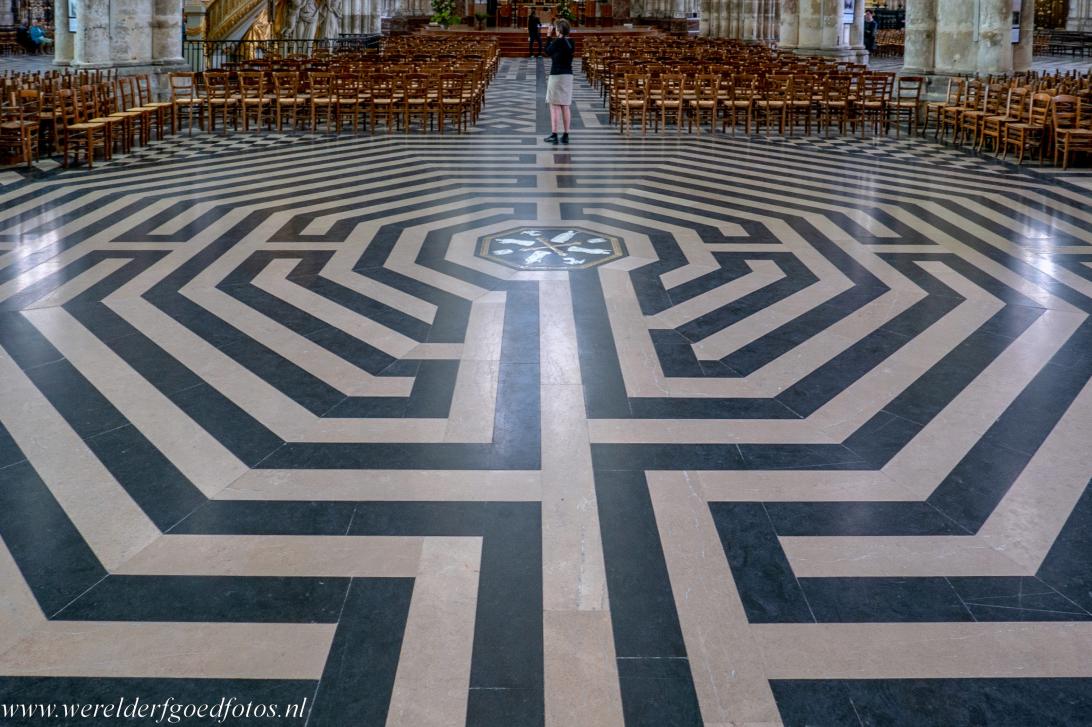
Amiens Cathedral: The labyrinth of Amiens Cathedral was inlaid in black and white marble in the nave floor in 1288. Labyrinths such as this were common in medieval cathedrals and churches. Pilgrims follow the path of the labyrinth on foot or on their knees while meditating; they hope to find relief and try to reach a deeper connection to God. The path also symbolizes the pilgrimage to Jerusalem and the Holy Land. The Amiens Labyrinth can be used for walking meditation.

Amiens Cathedral: The labyrinth of Amiens Cathedral was inlaid in black and white marble in the nave floor in 1288. Labyrinths such as this were common in medieval cathedrals and churches. Pilgrims follow the path of the labyrinth on foot or on their knees while meditating; they hope to find relief and try to reach a deeper connection to God. The path also symbolizes the pilgrimage to Jerusalem and the Holy Land. The Amiens Labyrinth can be used for walking meditation.
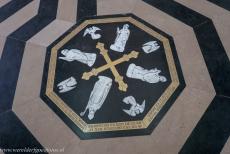
Amiens Cathedral: The central stone of the labyrinth of the cathedral depicts the figures of the bishop who took the initiative to erect the cathedral and the three principal architects who built the cathedral. The Amiens Labyrinth is the second largest in France; the original labyrinth did not survive the French Revolution intact. The present labyrinth is an exact copy, installed on the nave floor in the 19th century. The original central stone is on display in the Musée de Picardie.
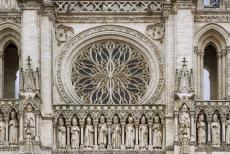
Amiens Cathedral: The rose window in the west façade is situated above the central part of the richly carved Gallery of the Kings. The immense rose window is 13 metres in diameter. The rose window was redesigned in the Flamboyant Gothic Style in the 16th century. In the middle of the rose window is the coat of arms of the donator of the window, three sculpted roosters. The rose window is situated above the main portal of the Amiens Cathedral.
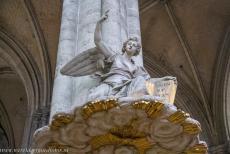
Amiens Cathedral: The sculpted angel on the sound board of the pulpit. The pulpit was made of white marble in the 18th century and is richly decorated with gilded wood accents. The pulpit is carried by three sculpted female figures, symbolizing the three theological virtues: Faith, Hope and Charity. Amiens Cathedral is situated in the heart of the historic Picardy region of France, about 120 km north of Paris. Amiens Cathedral was declared a UNESCO World Heritage in 1981.
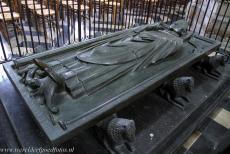
Amiens Cathedral: The 13th-century bronze tomb of Geoffroy d'Eu, Bishop of Amiens between 1222 and 1236. The cathedral also houses the 13th-century bronze tomb of Évrard de Fouilloy, Bishop of Amiens between 1211 and 1222. The monumental bronze tombs were cast in a single pour. They are two of the few remaining 13th century bronze tombs left in France; other bronze tombs were melted down and turned into weapons.
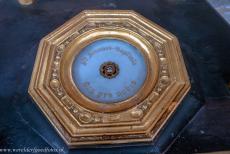
Amiens Cathedral: A fragment of the skull of John the Baptist, the forerunner of Jesus Christ. The reliquary that holds the Christian relic is a 19th-century copy of the medieval original. The skull of John the Baptist was discovered by a French crusader during the Fourth Crusade and brought to Amiens in 1206. This religious relic and other treasures have made the Amiens Cathedral an important Christian pilgrimage destination for centuries.
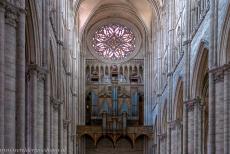
Amiens Cathedral: The nave looking towards the organ and the rose window in the western façade. The organ of Amiens Cathedral dates back to 1422; it was modified in the Renaissance style around 1549. The two side turrets were added around 1766. The High Gothic Rose window dates from the beginning of the 13th century. Napoleon Bonaparte paid a visit to the cathedral in 1803; he was struck by the majesty and beauty of the cathedral.
